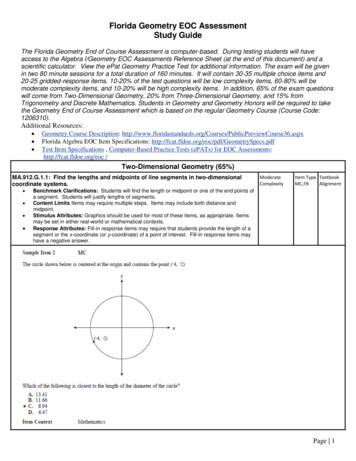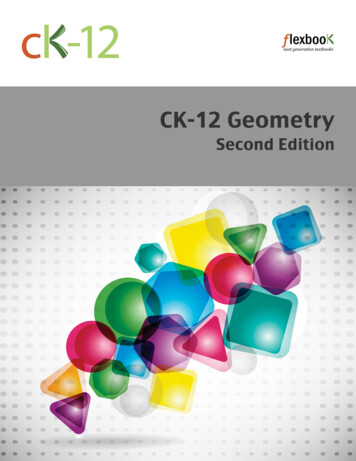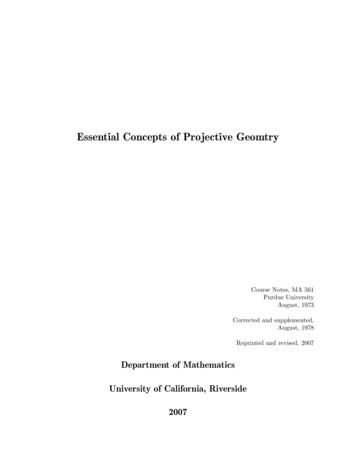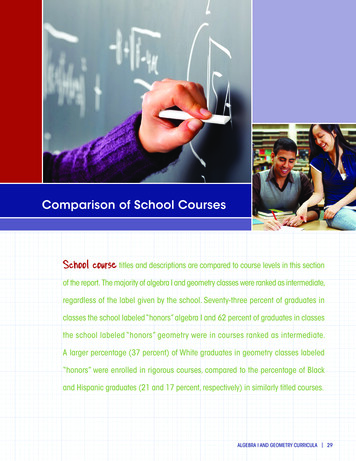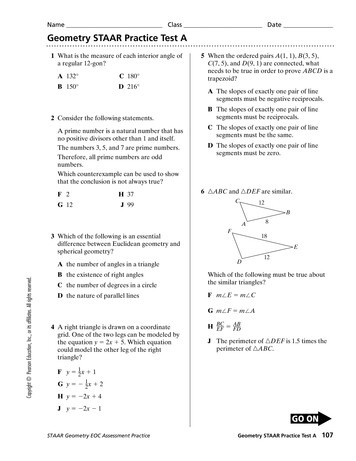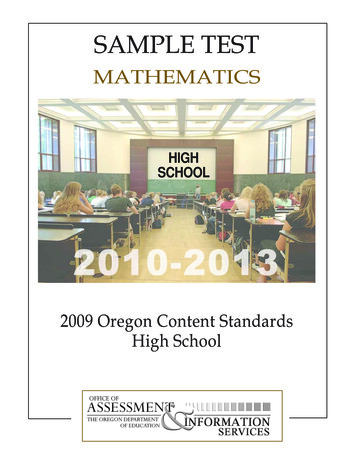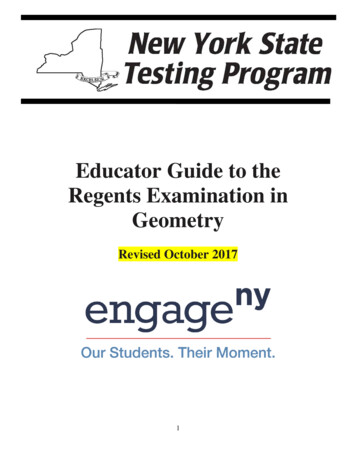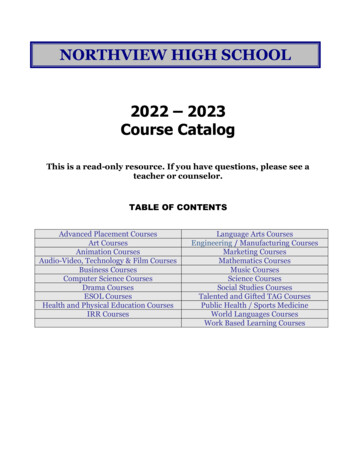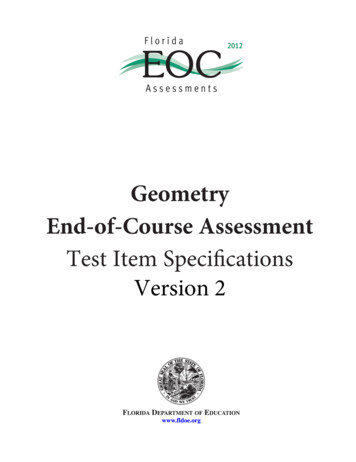
Transcription
GeometryEnd-of-Course AssessmentTest Item SpecificationsVersion 2
Copyright Statement for This Office of Assessment PublicationAuthorization for reproduction of this document is hereby granted to persons acting in an official capacity withinthe Uniform System of Public K–12 Schools as defined in Section 1000.01(4), Florida Statutes. The copyrightnotice at the bottom of this page must be included in all copies.All trademarks and trade names found in this publication are the property of their respective owners and are notassociated with the publishers of this publication.Permission is NOT granted for distribution or reproduction outside of the Uniform System of Public K–12 FloridaSchools or for commercial distribution of the copyrighted materials without written authorization from the FloridaDepartment of Education. Questions regarding use of these copyrighted materials should be sent to the following:The AdministratorOffice of AssessmentFlorida Department of EducationTallahassee, Florida 32399-0400Copyright 2012State of FloridaDepartment of State
TABLEOFCONTENTS1IntroductionOrigin and Purpose of the SpecificationsScope of this DocumentOverall Considerations3Criteria for Geometry End-of-Course Assessment ItemsUse of GraphicsItem Style and FormatScope of Test ItemsGuidelines for Item Writers8Item Difficulty and Cognitive Complexity of Geometry End-of-CourseAssessment ItemsItem DifficultyCognitive ComplexityUniversal Design15Review Procedures for Geometry End-of-Course Assessment Test ItemsReview for Potential BiasReview for Community SensitivityReview of Test Items16Guide to the Individual Benchmark SpecificationsBenchmark Classification SystemDefinitions of Benchmark SpecificationsGeneral Content Limits for EOC AssessmentsItem Contexts21Benchmarks Assessed on Algebra 1 End-of-Course Assessment and GeometryEnd-of-Course Assessment30Individual Benchmark Specifications for Geometry End-of-Course AssessmentGeometry End-of-Course Assessment Test Item Specifications iFlorida Department of Education i
A–1Appendix A: FCAT 2.0 and EOC Topics, Florida’s NGSSSB–1Appendix B: Mathematics Content Assessed by the Geometry EOC Assessment andItem Types by BenchmarkC–1Appendix C: Reporting Categories for FCAT 2.0 Mathematics and End-of-CourseAssessmentsD–1Appendix D: Mathematics Glossary, Algebra 1 EOC and Geometry EOCE–1Appendix E: Instructions for Item Review and Geometry EOC Item Rating FormF–1Appendix F: FCAT 2.0 Mathematics, Algebra 1 EOC, and Geometry EOC TestDesign SummaryG–1Appendix G: Algebra 1 End-of-Course and Geometry End-of-Course AssessmentsReference SheetH–1Appendix H: Response Gridsii Geometry End-of-Course Assessment Test Item SpecificationsFlorida Department of Education
INTRODUCTIONIn recent years, two realities focused attention on the need to reevaluate Florida’s Sunshine StateStandards (Standards). First, in 2005, outside consultants reviewed the 1996 Standards andsuggested that the benchmark language offer greater specificity to indicate clearly what teachersshould teach and what students should be able to do. Second, federal legislation through theNo Child Left Behind Act of 2001 (NCLB) holds schools and school districts accountable forhow well each child is learning, which further emphasized the need to hone expectations for allstudents.In January 2006, the Department of Education (DOE) committed to a six-year cycle of reviewand revision of the K–12 content standards. The mathematics standards were rewritten and theNext Generation Sunshine State Standards (NGSSS) for mathematics were adopted by theFlorida State Board of Education in September 2007 (available online dardSearch.aspx).The NGSSS are subdivided into benchmarks that identify what a student should know and beable to do. This document, Geometry End-of-Course Assessment Test Item Specifications(Specifications), provides information about the benchmarks, the stimulus types, and the testitems.The Florida Comprehensive Assessment Test 2.0 (FCAT 2.0) measures achievement of Floridastudents in writing, reading, mathematics, and science. End-of-course (EOC) assessmentsmeasure achievement of Florida students who have completed coursework in Algebra 1,Biology 1, Civics, Geometry, and U.S. History. The Geometry EOC Assessment measuresachievement of Florida students enrolled in Geometry, or an equivalent course, by assessingstudent progress on benchmarks from the NGSSS that are assigned to Geometry coursedescriptions.Origin and Purpose of the SpecificationsThe Florida Department of Education and committees of experienced Florida educatorsdeveloped and approved the Specifications. The Specifications is a resource document thatdefines the content and format of the test and test items for item writers and reviewers. EachSpecifications document indicates the alignment of items with the NGSSS. It also serves toprovide all stakeholders with information about the scope and function of the FCAT 2.0 andend-of-course assessments.Scope of this DocumentThe Specifications for the Geometry EOC Assessment provides general guidelines for thedevelopment of all test items used in the Geometry EOC Assessment. Three additionalSpecifications documents provide the same information for FCAT 2.0 Mathematics grades 3–5and grades 6–8 and for the Algebra 1 EOC assessment.The Overall Considerations section in this Introduction provides an explanation of themathematics elements assessed by the test. The Criteria for Geometry End-of-CourseAssessment Items section addresses the quality of the stimuli and test items and selection anddevelopment of multiple-choice and fill-in response items. The Item Difficulty and CognitiveComplexity section addresses cognitive-complexity levels as well as item difficulty anduniversal design. The Individual Benchmark Specifications section contains specificGeometry End-of-Course Assessment Test Item Specifications 1Florida Department of Education 1
information about each benchmark. This section provides benchmark clarification statements,content limits, stimulus attributes, response attributes, and a sample item for each benchmarkgrouping.Overall ConsiderationsThis section of the Specifications describes the guidelines that apply to all test items developedfor the Geometry EOC Assessment.Overall considerations are broad item-development issues that should be addressed during thedevelopment of test items. Other sections relate more specifically to one aspect of thedevelopment (e.g., item types or content limits).1. Each test item should be written to measure primarily one benchmark; however,other benchmarks may also be reflected in the item content.2. When benchmarks are combined for assessment, the individual specificationindicates which benchmarks are combined.3. Test items should be course appropriate for students in terms of difficulty, cognitivedevelopment, and reading level.4. Test items will exhibit a varied range of difficulty.5. Test items should not disadvantage or exhibit disrespect to anyone in regard to age,gender, race, ethnicity, language, religion, socioeconomic status, disability, orgeographic region.6. For the Algebra 1 End-of-Course Assessment, a four-function calculator will beallowed. For the Geometry End-of-Course Assessment, a scientific calculator willbe allowed.7. Test items may require the student to apply mathematical knowledge described inNGSSS benchmarks from lower grades; however, the benchmarks from lowergrades will not be assessed in isolation.8. Test items should provide clear and complete instructions to students.9. Each test item should be written to clearly elicit the desired response.10. A reference sheet containing appropriate formulas and conversions is provided tostudents taking the Algebra 1 EOC Assessment and the Geometry EOC Assessmentfor use during testing. Copies of the reference sheets are included in Appendix G ofthis document.11. Test items on the EOC assessments should be written so that students are expectedto select or provide the most accurate answer possible. Students should not rounddecimal equivalents and/or approximations until the final step of the item or task.Whenever possible, the test item stem should specify the decimal place, equivalentfraction, and/or pi approximation needed for the answer. In most cases, front-endestimation and truncation are not accurate processes for estimation.2 Geometry End-of-Course Assessment Test Item SpecificationsFlorida Department of Education
CRITERIAFORGEOMETRY END-OF-COURSE ASSESSMENT ITEMSThe Geometry EOC Assessment includes two types of test items: multiple-choice items (MC) andfill-in response items (FR). The general specifications on pages 3 through 14 cover the followingcriteria: Use of GraphicsItem Style and FormatScope of Test ItemsGuidelines for Item WritersItem Difficulty and Cognitive Complexity of Geometry End-of-CourseAssessment Items Universal DesignUse of GraphicsGraphics are used extensively in the Geometry EOC Assessment to provide both necessary andsupplemental information. That is, some graphics contain information that is necessary foranswering the question, while other graphics illustrate or support the context of the question. Allartwork must be high quality.Most of the individual benchmark specifications in the Specifications indicate the extent towhich graphics should be used to support test items developed for the benchmark. When noreference is made to the use of graphics, graphics are not required, although they may be used.Item Style and FormatThis section presents stylistic guidelines and formatting directions that should be followed whiledeveloping test items. Guidelines are provided separately for each item type to be developed.General Guidelines1. Items should be clear and concise, and they should use vocabulary and sentencestructure appropriate for the assessed grade level.2. The final sentence of any MC or FR item stem must be expressed as a question.3. If an item or task asks a question involving the word not, the word not should beemphasized by all uppercase letters (e.g., “Which of the following is NOT anexample of . . .”).4. For MC and FR items that refer to an estimate (noun), lowercase letters should beused.5. As appropriate, boldface type should be used to emphasize key words in the testitem question (e.g., least, most, greatest, percent, mode, median, mean, range,etc.).6. Masculine pronouns should NOT be used to refer to both sexes. Plural formsshould be used whenever possible to avoid gender-specific pronouns (e.g., insteadof “The student will make changes so that he . . . ,” use “The students will makechanges so that they . . .”).7. An equal balance of male and female names should be used, including namesrepresenting different ethnic groups appropriate for Florida.Geometry End-of-Course Assessment Test Item Specifications 3Florida Department of Education 3
8. For clarity, operation symbols, equality signs, and ordinates should be preceded andfollowed by one space.9. Decimal numbers between -1 and 1 (including currency) should have a leadingzero.10. Metric numbers should be expressed in a single unit when possible (e.g.,1.4 kilograms instead of 1 kilogram 400 grams).11. Decimal notation should be used for numbers with metric units (e.g., 1.2 gramsinstead of 1 15 grams).12. The comma should be used in a number greater than or equal to 1,000 when thenumber is given in the context of the problem. If a number greater than or equalto 1,000 is presented in an equation or an algebraic expression, no comma shouldbe used. Metric numbers with four digits should be presented without a comma or aspace (e.g., 9960 meters). For metric numbers with more than four digits, a thinspace should be inserted in place of a comma (e.g., 10123 kilograms). Dollaramounts of 1,000 or more should include commas.13. Units of measure should be spelled out, except in graphics where an abbreviationmay be used (e.g., ft or yd). Abbreviations that also spell a word must bepunctuated to avoid confusion. For example, to avoid confusion with thepreposition in, the abbreviation in. should include a period and should be used forthe unit of measure inches. If an abbreviation is used in a graphic, an explanationof the meaning of the abbreviation should be included in the stem.14. In titles for tables and charts and in labels for axes, the units of measure should beincluded, preferably in lowercase and in parentheses, e.g., height (in inches).15. Fractions should be typed with a horizontal fraction bar. The numerator anddenominator should be centered with respect to each other. The bar should cover allportions (superscripts, parentheses, etc.) of the numerator and denominator. In amixed number, a half space should appear between the whole number and thefraction. If a variable appears before or after a fraction bar, the variable should becentered with respect to the fraction bar. If a stimulus, stem, or set of responsescontains a fraction in fractional notation, that portion of the item should be1.5-spaced.16. In general, numbers zero through nine should be presented as words, and numbers10 and above should be presented as numerals. In the test item stem, any numbersneeded to compute answers should be presented as numerals.17. In MC items where is used in the stem, the question or answer options shouldaddress which form of should be used or if the answer will be kept in form. InFR items, the question should address which form of should be used or the keyanswer should account for using 22/7 or 3.14.18. All angle measurements will be in degrees.4 Geometry End-of-Course Assessment Test Item SpecificationsFlorida Department of Education
Multiple-Choice (MC) Items1. MC items should take an average of two minutes per item to solve.2. MC items are worth one point each.3. MC items should have four answer choices (A, B, C, and D).4. The correct response should be indicated.5. During item development and review, the rationale for distractors (incorrect answeroptions) should be indicated and set off in brackets.6. In most cases, answer options should be arranged vertically beneath the item stem.7. If four graphics are labeled horizontally or vertically and horizontally, the labelingshould be as follows:A. B. C. D.orA. C.B. D.Figure 1 Figure 2 Figure 3 Figure 4orFigure 1Figure 2Figure 3Figure 48. If the answer options for an item are strictly numerical, they should be arranged inascending or descending order, with the place values of digits aligned. When theitem requires the identification of relative size or magnitude, options should bearranged as they are presented in the item stem.9. If the answer options for an item are neither strictly numerical nor denominatenumbers, the options should be arranged by the logic presented in the question, byalphabetical order, or by length.10. Distractors should represent computational or procedural errors commonly made bystudents who have not mastered the assessed concepts. Each distractor should be abelievable answer for someone who does not really know the correct answer.11. Outliers (i.e., answer choices that are longer phrases or sentences than the otherchoices, or choices with significantly more/fewer digits than the other choices)should NOT be used.12. Responses such as “None of the Above,” “All of the Above,” and “Not Here”should not be used.13. Responses such as “Not Enough Information” or “Cannot Be Determined” shouldnot be used unless they are a part of the benchmark being assessed. They shouldnot be used as distractors for the sake of convenience.14. If a response is a phrase, the phrase should start with a lowercase letter. No periodshould be used at the end of a phrase.15. If a response is a sentence, the sentence should be conventionally capitalized andpunctuated.Geometry End-of-Course Assessment Test Item Specifications 5Florida Department of Education 5
Fill-In Response (FR) Items1. The Algebra 1 EOC and Geometry EOC Assessments use FR items.2. FR items should take an average of 2.5 minutes per item to complete.3. FR items are worth one point each.4. Multiple formats (e.g., equivalent fractions and decimals) are acceptable for itemsas long as each form of the correct response can be recorded in the grid.5. FR items may have a negative answer.6. FR items should include instructions that specify the unit in which the answer is tobe provided (e.g., inches). If several units of measure are in the item (e.g., in anitem involving a conversion), the final unit needed for the answer should be writtenin boldface.7. FR items are written with consideration for the number of columns in theresponse box.8. The Algebra 1 EOC and Geometry EOC Assessments are computer based and willuse a seven-column fill-in response box for items not assessed by multiple choice.Scope of Test ItemsThe scope of Geometry EOC Assessment test items is presented in Appendix B, which gives thebenchmarks for Geometry. The benchmarks serve as the objectives to which the test items arewritten. There may be additional specifications or restrictions by grade level or course; these aregiven in the General Content Limits section of the Specifications.Some of the benchmarks are assessed across grades 3–8, Algebra 1, and Geometry. Thesebenchmarks are introduced at one grade with the understanding that they will be assessed athigher levels of difficulty in each succeeding grade. Florida’s NGSSS are available dardSearch.aspx.6 Geometry End-of-Course Assessment Test Item SpecificationsFlorida Department of Education
Guidelines for Item WritersItem writers must have a comprehensive knowledge of the assessed mathematics curriculum anda strong understanding of the cognitive abilities of the students taking the test. Item writers shouldknow and consistently apply the guidelines established in these Specifications as well ascontribute to the goal of developing test content that allows students to perform at their best. Itemwriters are also expected to use their best judgment in writing items that measure the mathematicsbenchmarks of the NGSSS without introducing extraneous elements that reflect bias for oragainst a group of students.Item writers for Geometry EOC must submit items in a particular format and must include thefollowing information about each item. Because items are rated by committees of Floridaeducators following submission to the DOE, familiarity with the directions for rating items(found in Appendix E) would prove useful to all item writers.FormatItem writers must submit test items in the agreed-upon template. Allappropriate sections of the template should be completed before theitems are submitted.SourcesItem writers are expected to provide sources of all verifiableinformation included in the test item. Acceptable sources includeup-to-date textbooks, magazines and journals respected by themathematics community, and Internet sites maintained by reputableorganizations such as universities. It may be necessary to providesources verifying why a correct answer is correct, as well as whyother responses are incorrect.CorrectResponseItem writers must supply the correct response. For multiple-choice items, this includes an explanation of whyeach distractor is incorrect. For fill-in response items, this includes explanations of why thecorrect answer is correct and an explanation of additionalpossible correct answers.Submissionof ItemsWhen submitting items, item writers must balance several factors.Item submissions should include test items of varying difficulty; include test items of varying cognitive complexity; have an approximate balance, for multiple-choice items, of thecorrect response among the four answer options; have an equal balance of male and female names; and include names representing different ethnic groups in Florida.Geometry End-of-Course Assessment Test Item Specifications 7Florida Department of Education 7
ITEM DIFFICULTY AND COGNITIVE COMPLEXITY OFGEOMETRY END-OF-COURSE ASSESSMENT ITEMSEducational standards and assessments can be aligned based on the category of content coveredand also on the complexity of knowledge required. The Geometry EOC Assessment items, whileassessing Florida’s NGSSS, must also reflect this goal and standard. It is important to developitems that elicit student responses that demonstrate the complexity of knowledge and skillsrequired to meet these objectives. The degree of challenge of FCAT 2.0 and EOC items iscurrently categorized in two ways: item difficulty and cognitive complexity.Item DifficultyThe difficulty of FCAT 2.0 and EOC items is initially estimated by committees of educatorsparticipating in Item Content Review meetings each year. As each test item is reviewed,committee members make a prediction of difficulty based upon their knowledge of studentperformance at the given grade level. The classification scheme used for this prediction of itemdifficulty is based on the following:EasyMore than 70 percent of the students are likely to respond correctly.AverageBetween 40 percent and 70 percent of the students are likely to respondcorrectly.ChallengingFewer than 40 percent of the students are likely to respond correctly.After an item appears on a test, item difficulty refers to the actual percentage of students whochose the correct answer.8 Geometry End-of-Course Assessment Test Item SpecificationsFlorida Department of Education
Cognitive ComplexityCognitive complexity refers to the cognitive demand associated with a test item. In the early yearsof the FCAT program, the DOE used Bloom’s Taxonomy1 to classify test items; however, Bloom’sTaxonomy is difficult to use because it requires an inference about the skill, knowledge, andbackground of the students responding to the item. Beginning in 2004, the DOE implemented anew cognitive classification system based upon Dr. Norman L. Webb’s Depth of Knowledge(DOK) levels.2 The rationale for classifying an item by its DOK level of complexity focuses onthe expectations made of the item, not on the ability of the student. When classifying an item’sdemands on thinking (i.e., what the item requires the student to recall, understand, analyze, anddo), it is assumed that the student is familiar with the basic concepts of the task. Test items arechosen for the FCAT 2.0 and EOC assessments based on the NGSSS and their grade-level orcourse appropriateness, but the complexity of the items remains independent of the particularcurriculum a student has experienced. On any given assessment, the cognitive complexity of amultiple-choice item may be affected by the distractors (answer options). The cognitivecomplexity of an item depends on the grade level of the assessment; an item that has a high levelof cognitive complexity at one grade may not be as complex at a higher grade.The categories—low complexity, moderate complexity, and high complexity—form an ordereddescription of the demands an item may make on a student. For example, low-complexity itemsmay require a student to solve a one-step problem. Moderate-complexity items may requiremultiple steps. High-complexity items may require a student to analyze and synthesizeinformation. The distinctions made in item complexity ensure that items will assess the depthof student knowledge at each benchmark. The intent of the item writer weighs heavily indetermining the complexity of an item.The pages that follow illustrate some of the varying demands that items might make at eachcomplexity level for Geometry. Note that items may fit one or more descriptions. In mostinstances, these items are classified at the highest level of complexity demanded by the item.Caution must be used in referring to the chart of descriptors that is provided for each cognitivecomplexity level. This chart is provided for ease of reference, but the ultimate determination ofitem complexity should be made considering the overall cognitive demand placed on a student.A table also provides the breakdown of the percentage of points by cognitive-complexity level.Item writers are expected to evaluate their items in terms of cognitive complexity and includethis on the item template. Test items should be written to the highest level of complexity asappropriate to the assessed benchmark.12Bloom, B.S. et al. Taxonomy of Educational Objectives, Handbook I: Cognitive Domain. New York: McKay, 1956.Webb, Norman L. and others. “Web Alignment Tool” 24 July 2005. Wisconsin Center for Education Research. University ofWisconsin-Madison. 2 Feb. 2006. http://www.wcer.wisc.edu/WAT/index.aspx.Geometry End-of-Course Assessment Test Item Specifications 9Florida Department of Education 9
Low ComplexityGeometry low-complexity items rely on recall or recognition of a course-related fact, property, orconcept. Items may rely on previously learned concepts and principles.Below is an example of a low-complexity test item that is based on Benchmark MA.912.G.5.4.For more information about this benchmark, see page 58.The dimensions and shape of a rectangular volleyball court are shown in this picture.18 meters9 metersWhat is the approximate distance of a serve that is hit diagonally from one corner of the court tothe other?A. B.C.D.1027.0 meters20.1 meters15.6 meters12.7 meters Geometry End-of-Course Assessment Test Item SpecificationsFlorida Department of Education
Moderate ComplexityGeometry moderate-complexity items involve flexible thinking while applying basic skills andconcepts of geometry. Items may require more than one step, and the student may be expected todecide which geometric concepts to apply.Below is an example of a moderate-complexity test item that is based on BenchmarkMA.912.G.2.2. For more information about this benchmark, see page 37.In the figure below, BD and AF intersect at point C.AD62.7 CE132.8 46.9 x BFWhat is the value of x?6 6.8Correct Answer: 66.8Geometry End-of-Course Assessment Test Item SpecificationsFlorida Department of Education 11
High ComplexityGeometry high-complexity items may require the student to reason, justify, or explain theirthinking. Students may develop a plan to solve the problem. Items often require several decisionpoints, abstract reasoning, or analysis.Below is an example of a high-complexity test item that is based on Benchmark MA.912.G.7.5.For more information about this benchmark, see page 68.Tobias is restoring an antique lamp like the one pictured below. The base of the lamp iscylindrical with a height of 19 12 inches and a diameter of 1 14 inches. He will use gold leaf tocover the lateral surface area of the base of the lamp.TOBIAS’S LAMPBase of lampThe gold-leaf material Tobias will use comes in square pieces that measure 3 38 inches by3 38 inches. What is the least number of these pieces of gold-leaf material Tobias will needto completely cover the lateral area of the lamp’s base?7Correct Answer: 712 Geometry End-of-Course Assessment Test Item SpecificationsFlorida Department of Education
The following chart is provided for ease of reference; however, caution must be used inreferring to this chart of descriptors for each cognitive-complexity level. The ultimatedetermination of an item’s cognitive complexity should be made considering the intent of theoverall cognitive demand placed on a student.Examples of FCAT 2.0 and EOC Mathematics Activitiesacross Cognitive-Complexity LevelsLow ComplexityModerate ComplexityHigh Complexity Recall or recognize a fact,term, or property. Identify appropriate unitsor tools for commonmeasurements. Compute a sum, difference,product, or quotient. Recognize or determine anequivalent representation. Calculate the value of anexpression, given specificvalues for the variables. Solve a one-step problem. Retrieve information froma graph, table, or figure. Perform a single-unitconversion (e.g., feet toinches). Solve a problem requiringmultiple operations. Solve a problem involvingmultiple transformations ofa figure or spatialvisualization or reasoning. Retrieve information froma graph, table, or figure anduse it to solve a problem. Compare figures orstatements. Determine a reasonableestimate. Extend an algebraic orgeometric pattern. Explain steps of a solutionprocess. Translate and solve aroutine problem, given dataand conditions. Represent a situationmathematically in morethan one way. Solve real-world problemsusing multiple steps andmultiple decision points. Describe how differentrepresentations can be usedfor different purposes. Solve a nonroutineproblem (as determined bygrade-levelappropriateness). Analyze similarities anddifferences betweenprocedures and concepts. Generalize an algebraic orgeometric pattern. Formulate an originalproblem, given a situation. Solve a problem in morethan one way. Provide a mathematicalexplanation and/orjustification to a problem. Describe, compare, andcontrast solution methods. Formulate a mathematicalmodel for a complexsituation. Analyze or produce adeductive argument.Geometry End-of-Course Assessment Test Item Specifications 13Florida Department of Education 13
Items are classified on the cognitive demand inherent in the test items, not on assumptionsabout the student’s approach to the items. Low-complexity items rely heavily on recall andrecognition. Moderate-complexity items require more flexible thinking and may requireinformal reasoning or problem solving. High-complexity items are written to elicit analysis andabstract reasoning.The table below presents the range for the percentage of raw-score points bycognitive-complexity level on each mathematics assessment.Percentage of Points by Cognitive-Complexity Level for FCAT 2.0 and EOC 0–8010–20Algebra 0Universal DesignThe application of universal design principles helps develop assessments that ar
Mathematics Glossary, Algebra 1 EOC and Geometry EOC . E-1 Appendix E: Instructions for Item Review and Geometry EOC Item Rating Form . F-1 Appendix F: FCAT 2.0 Mathematics, Algebra 1 EOC, and Geometry EOC Test Design Summary . G-1 Appendix G: Algebra 1 End-of-Course and Geometry End-of-Course Assessments Reference Sheet

